What Does the Term Gothic Mean When Applied to Art and Architecture 1900
Gothic architecture commencement became popular in the Late Eye Ages in Europe. Its prime era was the late 12th to the 16th century, but it connected in some areas into the 17th and 18th centuries. It followed the Romanesque menstruation of Medieval Europe and was followed by the Renaissance period. Early Gothic architecture first originated in northern France in the region known as Île-de-French republic and evolved out of the local Norman architecture. Gothic style architecture was sometimes referred to every bit Opus Francigenum (French Work) and it was merely during the Renaissance menstruation that the term "Gothic" was used as a disdainful insult past those who were more than interested in reviving Grecian compages.
Table of Contents
- 1 What Is Gothic Architecture?
- 1.1 The Difference Betwixt Gothic vs. Romanesque Compages
- 1.two In Which Country Did the Gothic Style First Emerge?
- one.3 Characteristic Elements of Gothic Style Architecture
- ii Famous Examples of Gothic Architecture
- 2.1 The Basilica of Saint-Denis (1135)
- 2.2 St. Stephen's Cathedral (1160)
- 2.three Notre-Matriarch de Paris (1163)
- 2.4 Seville Cathedral (1172)
- 2.v Lincoln Cathedral (1185)
- 2.half-dozen Chartres Cathedral (1194)
- ii.7 Zagreb Cathedral (1217)
- 2.8 Salisbury Cathedral (1220)
- 2.ix Amiens Cathedral (1220)
- 2.10 York Minster (1230)
- 2.eleven The Cologne Cathedral (1248)
- 2.12 Orvieto Cathedral (1290)
- 2.13 Santa Maria del Fiore (1296)
- 2.xiv Saint Vitus Cathedral (1344)
- two.15 Milan Cathedral (1386)
- 2.16 The Grote Kerk (1410)
- 3 Frequently Asked Questions
- 3.1 In Which Country Did the Gothic Way Outset Emerge?
- iii.2 What Are Some of the Characteristics of Gothic Architecture?
What Is Gothic Architecture?
The about noticeable design features of Gothic structures are the pointed or ogival arches. Flying buttresses are some other design element and also the primary engineering innovation of the manner. Pointed arches allowed for the development of new structural elements such every bit pointed vaults and the flight buttress, and the incorporation of elaborate stone tracery and stained glass windows.
Gothic architects have incorporated the style into many types of buildings such as Gothic churches and Gothic cathedrals, parish churches, abbeys, palaces, castles, universities, and town halls.
 A collage of diverse Gothic structures. Upper row: Clermont-Ferrand Cathedral (Rayonnant Gothic and Gothic Revival), North Rose window of Notre-Dame de Paris (Rayonnant Gothic), Chartres Cathedral (Loftier Gothic). Lower row: Reims Cathedral (High Gothic), Notre-Dame de Paris (Early and High Gothic), Loftier choir of Beauvais Cathedral (Late Gothic), Clermont-Ferrand Cathedral (Rayonnant Gothic and Gothic Revival);MathKnight ✡ (Talk) and the orginal photographers, see beneath, CC BY-SA four.0, via Wikimedia Commons
A collage of diverse Gothic structures. Upper row: Clermont-Ferrand Cathedral (Rayonnant Gothic and Gothic Revival), North Rose window of Notre-Dame de Paris (Rayonnant Gothic), Chartres Cathedral (Loftier Gothic). Lower row: Reims Cathedral (High Gothic), Notre-Dame de Paris (Early and High Gothic), Loftier choir of Beauvais Cathedral (Late Gothic), Clermont-Ferrand Cathedral (Rayonnant Gothic and Gothic Revival);MathKnight ✡ (Talk) and the orginal photographers, see beneath, CC BY-SA four.0, via Wikimedia Commons
UNESCO has listed many Gothic structures as World Heritage Sites. It is believed by some scholars that the epitome for Gothic compages was the architecture of the Christian Armenians, however, despite many similarities with Gothic style compages that tin can be observed in buildings such every bit the Ani Cathedral'southward vaulted ribs and pointed arches, at that place is a gap of several centuries between the architecture styles and no real evidence to prove any connection between them.
The 15th century witnessed the ushering in of Renaissance architecture, which would soon replace Gothic architecture as the new preferred way.
Yet, in some places like Kingdom of belgium and England, the Gothic way would proceed and evolve well into the 16th century. From the mid-18th century into the 20th century, there were a series of revivals of Gothic-mode architecture, generally used in the designs of university buildings and churches.
The Deviation Between Gothic vs. Romanesque Architecture
Early Gothic architecture was heavily influenced by the preceding compages of the Romanesque menstruation. Romanesque buildings used rounded arches and comparatively pocket-sized windows, whereas Gothic architects preferred using pointed arches and a lot of stained drinking glass, resulting in an airier and brighter interior compared to the dark and stuffy interior of Romanesque compages.
Much of the requirement for more light was based on literal interpretations of theological doctrines, and new improvements regarding technical elements such as buttresses and vaults allowed for larger and higher windows than before.
 Gothic architectural elements and details; Internet Archive Volume Images, No restrictions, via Wikimedia Eatables
Gothic architectural elements and details; Internet Archive Volume Images, No restrictions, via Wikimedia Eatables
Other influences that drove the construction of more Gothic structures were the rise in wealth and population numbers, resulting in churches and cathedrals needing to be built larger in order to adjust the influx of pilgrims. The Romanesque buildings were proving too small for the ever-growing populace. Gothic architects wanted to limited the grandeur and power of the ascent in the nation'southward prosperity in their buildings.
I fundamental feature of Romanesque architecture that was not used in Gothic architecture was thick walls. Gothic architects used flying buttresses as support so that they could make walls thinner and college than those of the Romanesque style.
In Which Land Did the Gothic Style Starting time Emerge?
Running parallel to the development of early Gothic compages was Norman architecture which was popular in the 11th century in Normandy and England. Buildings such every bit the Lessay Abbey in Normandy and the Durham Cathedral display like elements to Gothic compages such as Rib-vaults.
Still, the first structures to exist considered as pure Gothic architecture are buildings found in French republic such as the funerary abbey belonging to the kings of French republic, the Abbey of Saint-Denis, as well as the Sens Cathedral in North-Fundamental French republic. These were the first Gothic structures to combine pointed arches, buttresses, and rib vaulting.
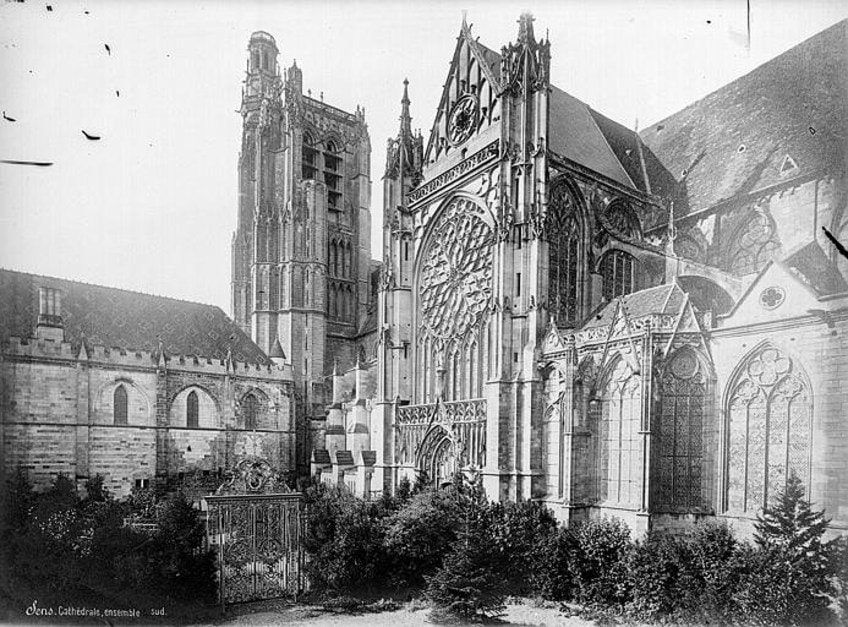 Sens Cathedral, 1905;Séraphin-Médéric Mieusement, CC By-SA four.0, via Wikimedia Commons
Sens Cathedral, 1905;Séraphin-Médéric Mieusement, CC By-SA four.0, via Wikimedia Commons
Characteristic Elements of Gothic Way Architecture
Certain architectural elements that tin be found in Gothic Cathedrals and other buildings of the Gothic style were already present in older buildings. Rib vaulting could, for example, be found in churches in England and Normandy. Yet, for buildings to be considered Gothic structures, they demand to have sure defining architectural features and structural elements.
Pointed Arches
Pointed arches were widely used in the decoration and structure of Gothic churches and buildings and are one of the most mutual features of Gothic-style compages. However, the pointed curvation is one of those architectural elements that are not exclusively plant in Gothic structures but had already been used for centuries in pre-Islamic and Islamic architecture. The pointed arches and alpine spires of Gothic architecture create a sensation of verticality and monumental acme and are the most visible element of the mode.
They were used both as decoration besides every bit for practical reasons such as bringing diagonal and transverse vaults to equal meridian.
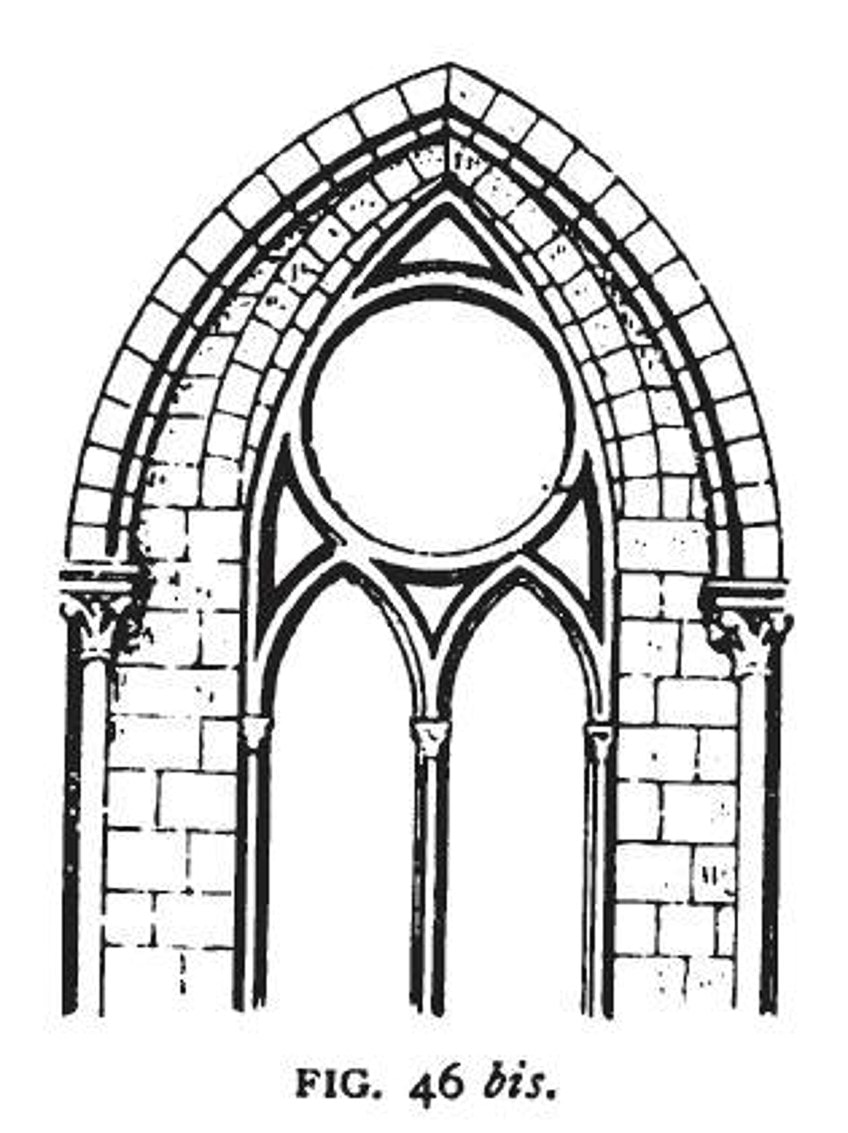 A diagram of a classic Gothic pointed arch;Charles Herbert Moore (1840-1930), Public domain, via Wikimedia Commons
A diagram of a classic Gothic pointed arch;Charles Herbert Moore (1840-1930), Public domain, via Wikimedia Commons
Rib Vaults
The large windows used in Gothic compages were made possible past the use of the rib vault, perchance the nearly of import structural element of these buildings. These Gothic rib vaults were made of biconvex ribs that crossed diagonally, thereby taking much of the strain of the weight. Romanesque buildings had a weight that diameter downward direct on the structure, so they required smaller windows and thick walls to concord the weight. With the rib vaults, the pressure of the weight was thrust outwards towards the vault's corners, and so downwards vai columns and colonettes to the columns beneath it.
 Gothic or rib vaults of the nave (left) and the abse (right) of the Primate Cathedral of the Americas, Colonial City of Santo Domingo, Dominican Republic;Mariordo (Mario Roberto Durán Ortiz), CC Past-SA 4.0, via Wikimedia Commons
Gothic or rib vaults of the nave (left) and the abse (right) of the Primate Cathedral of the Americas, Colonial City of Santo Domingo, Dominican Republic;Mariordo (Mario Roberto Durán Ortiz), CC Past-SA 4.0, via Wikimedia Commons
Piers and Columns
In early Gothic architecture, the capitals had been inspired by the Corinthian order columns of ancient Rome, along with the finely sculpted leaves. An early example of this can exist seen in the Abbey church of Saint-Denis. The architect of the abbey would state that he had been inspired past the style after seeing it in the baths in Rome.
They were also used in structures that were built afterward the Abbey such as those in Canterbury in England, and at the Notre Matriarch in Paris.
Early Gothic churches used rib vaults that were divided into six parts resulting in the columns in the nave alternating in size to support the vaults. When the 4-part rib was introduced, a standard design could be practical to all of the columns or piers. A central core design became pop in the High Gothic period, wherein several slender colonettes would connect the vaults to a centrally positioned core.
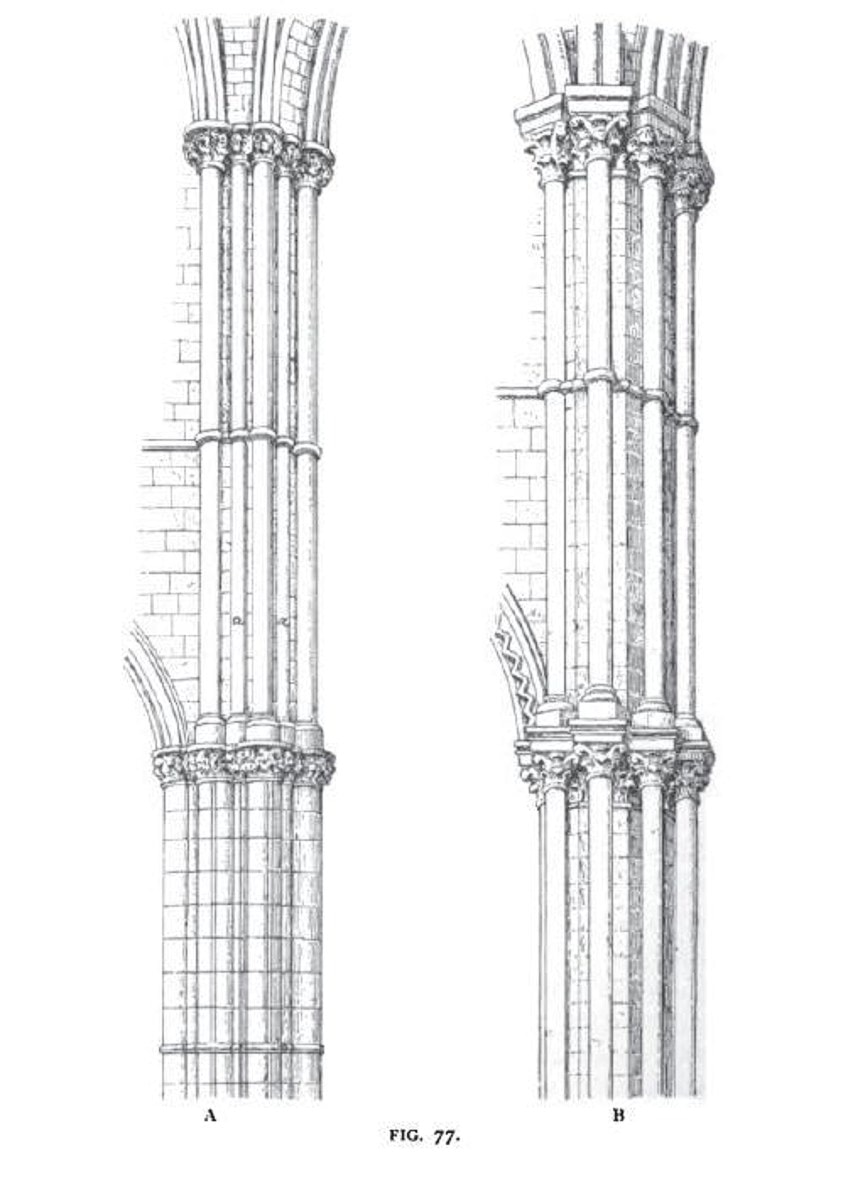 A diagram depicting the Gothic-style piers at the Crossing of Lincoln and Canterbury respectively;Charles Herbert Moore (1840-1930), Public domain, via Wikimedia Commons
A diagram depicting the Gothic-style piers at the Crossing of Lincoln and Canterbury respectively;Charles Herbert Moore (1840-1930), Public domain, via Wikimedia Commons
Flying Buttresses
Flying buttresses are structural support elements, these half-arch structures are outside the building and acquit the thrust of the roof or vault'due south weight. These buttresses were important features of Gothic architecture and they were positioned in rows on both sides of the building. Frequently they would exist topped with large stone pinnacles which served as decoration also every bit weight back up.
Buttresses were non a new architectural element but were usually prepare right against the building in Roman times.
The flying buttresses of the Gothic style were more circuitous and often had arches of varying sizes that each connected to diverse levels of the structure. By incorporating flying buttresses into their designs, Gothic architects were able to construct buildings that were higher than before without the need for thick walls, and galls could be incorporated likewise.
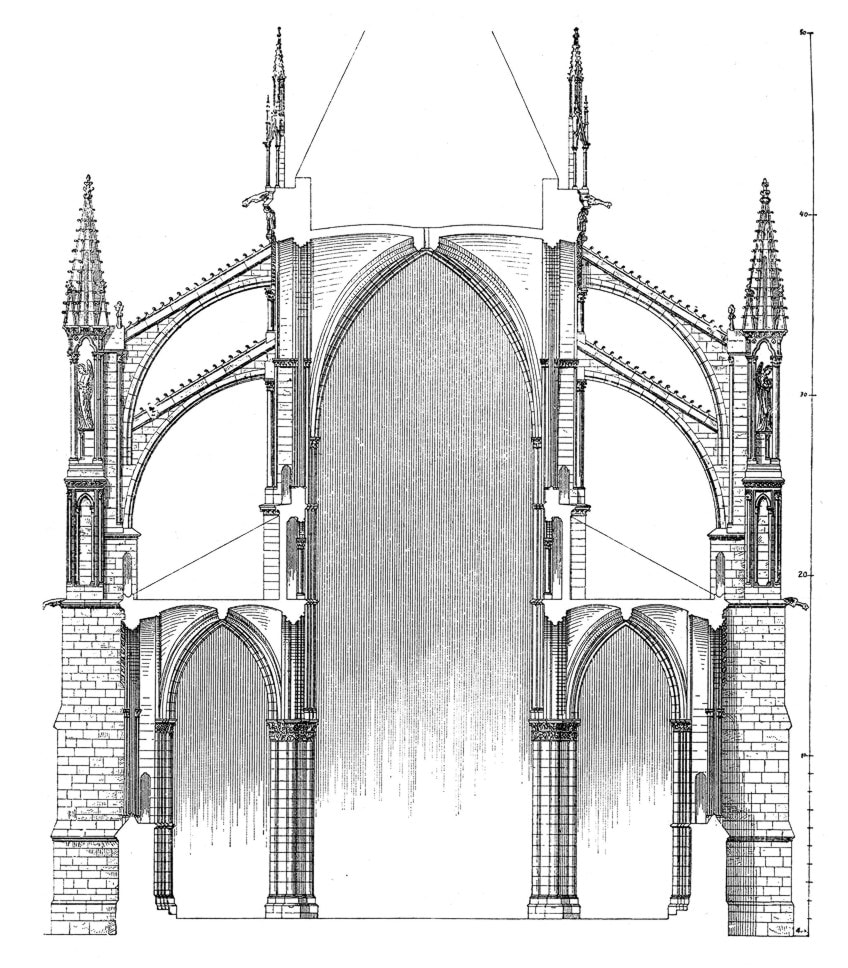 Section of Reims Cathedral showing the iii levels of each flight buttress (1211–1275);The original uploader was Rainer Zenz at German Wikipedia., Public domain, via Wikimedia Commons
Section of Reims Cathedral showing the iii levels of each flight buttress (1211–1275);The original uploader was Rainer Zenz at German Wikipedia., Public domain, via Wikimedia Commons
Spires and Towers
Another noticeable characteristic of Gothic compages is the use of spires and towers in their design. Their elevation created a dramatic advent and served to be a highlight of the urban center's skyline. For the architects, it represented their want to reach the heavens. Their purpose was non entirely artful though, as they were likewise used as bell towers to call people to religious service or to warn the townsfolk of possible invaders. In some cases, like with the Leaning Belfry of Pisa, the bell belfry is entirely separate from the rest of the church building.
Being one of the last elements to be built during the construction of a Gothic Church, they would ofttimes end up being congenital in a unlike way due to the long period of time information technology took to build the residue of the structure.
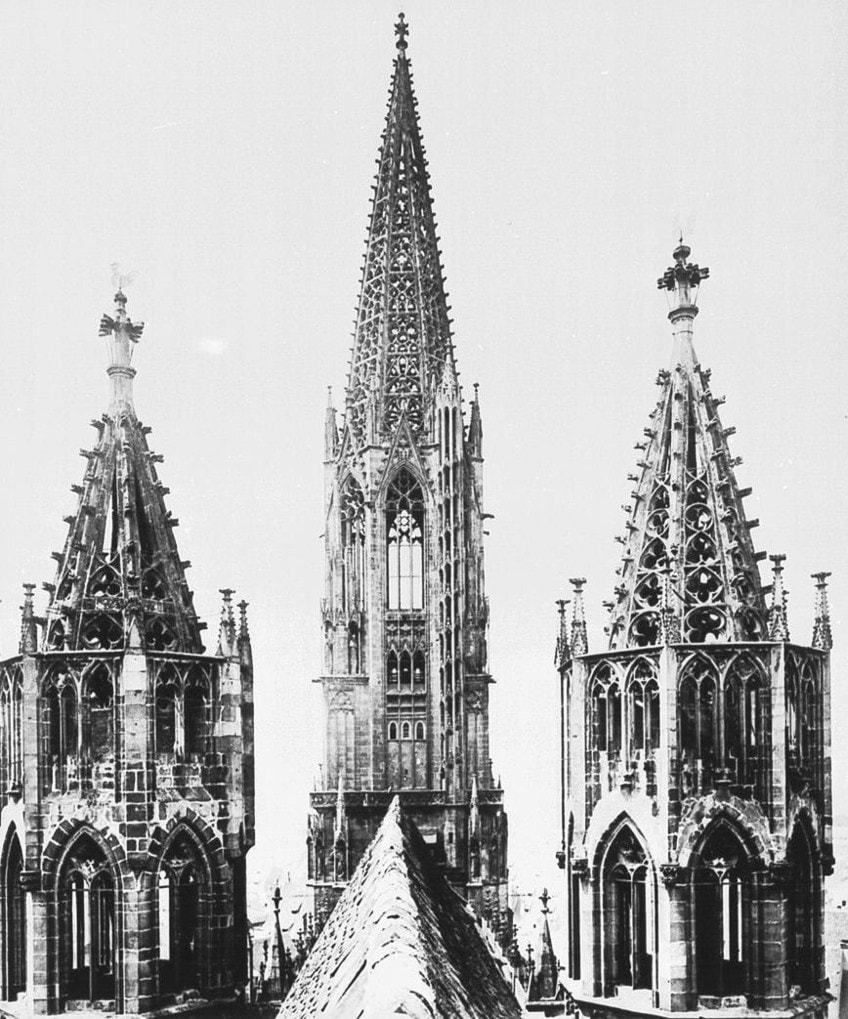 The towers and spires of Freiburg Minster, 1926;Vorlage Kempf, Public domain, via Wikimedia Eatables
The towers and spires of Freiburg Minster, 1926;Vorlage Kempf, Public domain, via Wikimedia Eatables
Tracery
Gothic architects wished to make full interior spaces with light past using glass-stained windows. All the same, large panels of glass would non be able to hold much weight and would hands break. A solution to this problem was found with the introduction of tracery. Past dividing windows into smaller sections using stone ribs or bars of molding, large sections of a wall could contain glass while still maintaining structural integrity. These windows could exist placed in intricate geometric patterns and ornate stained-glass designs.
 Detail of the Gothic tracery of a window in the dome of the Cathedral of Venice;Joanbanjo, CC BY-SA 3.0, via Wikimedia Eatables
Detail of the Gothic tracery of a window in the dome of the Cathedral of Venice;Joanbanjo, CC BY-SA 3.0, via Wikimedia Eatables
Labyrinths and Grotesques
The exteriors of Gothic buildings were ofttimes decorated with sculptures of apostles and saints. Withal, another regular characteristic of Gothic architecture is the grotesques or monsters such as the chimera and the Strix, both mythological beasts.
Other grotesques such as the gargoyles of Notre Matriarch served a more practical purpose, interim as decorated water spouts for the torrents of rain that poured from the roof.
Mazes or labyrinths were other features often found in Gothic structures and were meant to nowadays the difficulties and complications associated with the daily life of a Christian striving to attain a place in paradise.
 Gargoyles of Notre-Dame;Peter Cadogan, CC BY-SA iv.0, via Wikimedia Commons
Gargoyles of Notre-Dame;Peter Cadogan, CC BY-SA iv.0, via Wikimedia Commons
Famous Examples of Gothic Compages
The influence of the Gothic style was felt for hundreds of years. During that time many cute examples of Gothic cathedrals and buildings have been designed and constructed around the world. Now we shall take a closer look at some famous examples of Gothic structures.
The Basilica of Saint-Denis (1135)
| Location of Gothic Construction | Paris, France |
| Year Built | 1135 |
| Architect(s) | Abbot Suger (1081 – 1151) |
| Function of Building | Cathedral |
The famous basilica is situated in the Parisian suburb of Saint-Denis, and information technology is generally regarded equally the offset example of a edifice to display all the characteristics of Gothic-fashion compages, peculiarly its choir that was only completed in 1144. The site on which the Basilica of Saint-Denise now stands used to be a Roman cemetery, and the remains of the cemetery still lay below the building'south foundations.
It is the seat of the Bishop of Saint-Denis and despite existence called a basilica locally, the Vatican has as even so not granted the title on the building officially.
 North facade of the Basilica of Saint-Denis, before 1893;Séraphin-Médéric Mieusement, Public domain, via Wikimedia Commons
North facade of the Basilica of Saint-Denis, before 1893;Séraphin-Médéric Mieusement, Public domain, via Wikimedia Commons
The basilica receives many tourists every year and is considered an important place of religious pilgrimage. Near of the French Kings that reigned betwixt the tenth and 18th centuries are also laid to rest in their tombs which are housed at the basilica. In that location are also several kings from older periods resting in eternity at the basilica such as Charles Martel who was instrumental in crushing the invading forces of the Umayyad Caliphate in 732 at the Battle of Tours.
St. Stephen's Cathedral (1160)
| Location of Gothic Construction | Vienna, Republic of austria |
| Twelvemonth Built | 1160 |
| Architect(s) | Anton Pilgrim (1460 – 1516) |
| Function of Building | Cathedral |
St. Stephen's Cathedral is situated in Vienna, Austria, and is regarded to be the most prominent Gothic structure in the whole urban center. Many of Vienna's greatest treasures are currently stored in the cathedral. The edifice of the church building was first initiated past Knuckles Rudolf Iv and was designed past Anton Pilgrim. It was built on the site of two churches that had existed there earlier.
Information technology is regarded equally the well-nigh of import building in Vienna centered around faith and has witnessed many historical events over the years since its construction.
 St. Stephen's Cathedral in Vienna at the start of the 20th century;Unknown writer Unknown author, Public domain, via Wikimedia Eatables
St. Stephen's Cathedral in Vienna at the start of the 20th century;Unknown writer Unknown author, Public domain, via Wikimedia Eatables
The edifice displays features of both Gothic and Romanesque architecture. The cathedral was ordered to be demolished by German forces during World War II but refused direct orders to practise so. During some other menstruum of invasion in the metropolis locals burnt down their shops before the invading Soviet troops could enter the city. Unfortunately, the cathedral caught fire in the process and the roof collapsed. A unique characteristic of the church building is its multi-colored tile roof, which has helped the famous building get one of the most recognizable structures in the city.
Notre-Dame de Paris (1163)
| Location of Gothic Structure | Paris, France |
| Twelvemonth Built | 1163 |
| Architect(s) | Pierre de Montreuil (1200 – 1266) Jean-Baptiste-Antoine Lassus (1807 – 1857) |
| Function of Building | Cathedral |
The Notre Dame is situated in Paris and is regarded as a prime example of French Gothic architecture. What helped the cathedral stand out from the earlier Romanesque buildings was the abundance of sculptures, the colorful and huge rose windows, and of course the innovative use of flying buttresses and vaults that were unique at the time. Another feature that makes this building stand out is the big organ and church bells that the building is famous for.
This edifice is rated every bit ane of the most well-known and largest of churches in France and was designed by Pierre de Montreuil and afterwards additional piece of work was designed by Jean-Baptiste-Antoine Lassus.
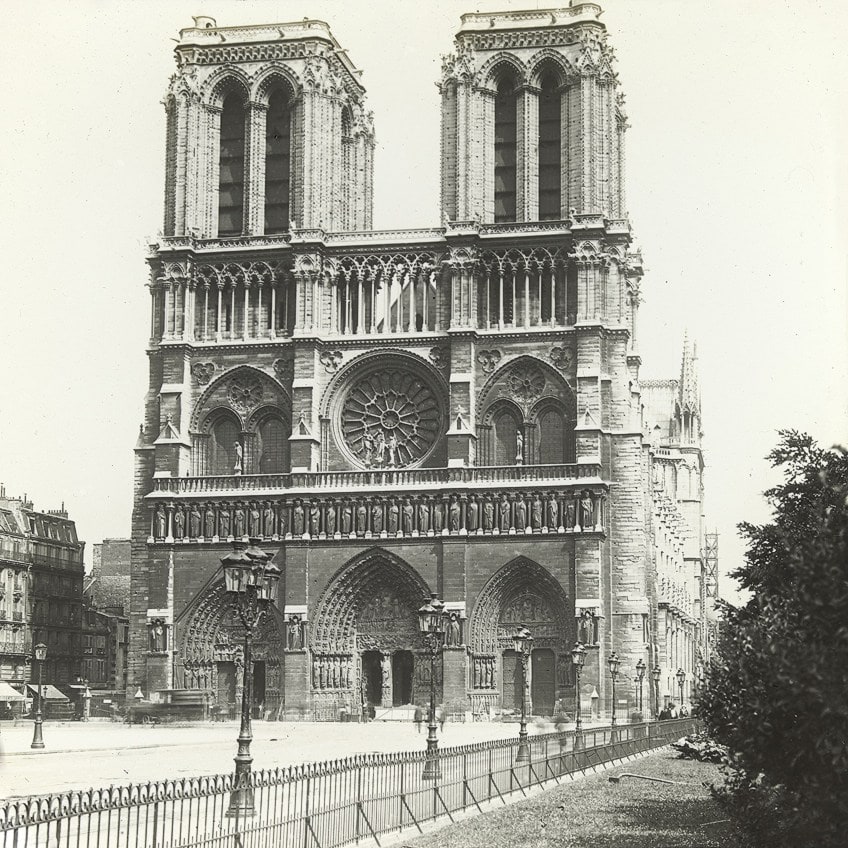 Notre Dame, Paris, French republic, c. 1900;State Library Victoria, Public domain, via Wikimedia Commons
Notre Dame, Paris, French republic, c. 1900;State Library Victoria, Public domain, via Wikimedia Commons
Piece of work on the cathedral began in 1163 and was finished in 1345. During the reigns of Louis XIV and his successor Louis Xv, the cathedral went through more extensive alterations. During the chaotic and destructive French revolution, the cathedral was badly damaged with much of the religious iconography destroyed. Restoration works started once again in 1845. The famous Gothic church also experienced damage during Earth War II when several of the stained drinking glass windows were destroyed by bullets which were later remade, but in a more modern design that incorporated geometric designs.
Seville Cathedral (1172)
| Location of Gothic Structure | Seville, Kingdom of spain |
| Year Congenital | 1172 |
| Builder(southward) | Alonso Martínez (c. 14th century) |
| Function of Building | Cathedral |
Seville Cathedral is rated as the largest Gothic cathedral globally. Information technology is situated in Seville, Kingdom of spain, and was listed as a UNESCO World Heritage site in 1987. It is also the world's fourth-largest church. When it was completed in the 16th century it was the largest Cathedral of its time, surpassing the tape held by the Hagia Sophia in Turkey. Juan of Aragon was baptized in the church building in 1478. The remains of several royal people such as Peter the Only, Ferdinand Iii of Castile, and his son Alfonso the Wise.
Another famous person buried at the cathedral is Christopher Columbus.
 Cathedral of Seville, 1895; By Unknown writer, Public Domain, Link
Cathedral of Seville, 1895; By Unknown writer, Public Domain, Link
The Medieval Cathedral of Seville was built on the site of a mosque known as Almohad Mosque. The builders of the cathedral used some elements of the mosque such as some columns to assist build certain parts such as the Giralda, the bell tower that was converted from a minaret. After the Reconquista in 1248, the cathedral was built to brandish the wealth of the urban center. The cathedra'southward interior boasts a nave that is unmatched in length by any other cathedral in Spain.
Lincoln Cathedral (1185)
| Location of Gothic Structure | Lincoln, England |
| Year Built | 1185 |
| Builder(south) | Hugh of Avalon (1140 – 1200) |
| Function of Building | Cathedral |
Lincoln Cathedral is regarded every bit i of the loftier points of English Gothic architecture. The westward front features Norman Arches and a 13th-century screen. In 1073 Bishop Remigus moved his seat from Dorchester to Lincoln. He then initiated the building of the cathedral and some of his work is still visible on the facade.
However, in 1185 an earthquake would striking Lincoln and exit the cathedral in ruins.
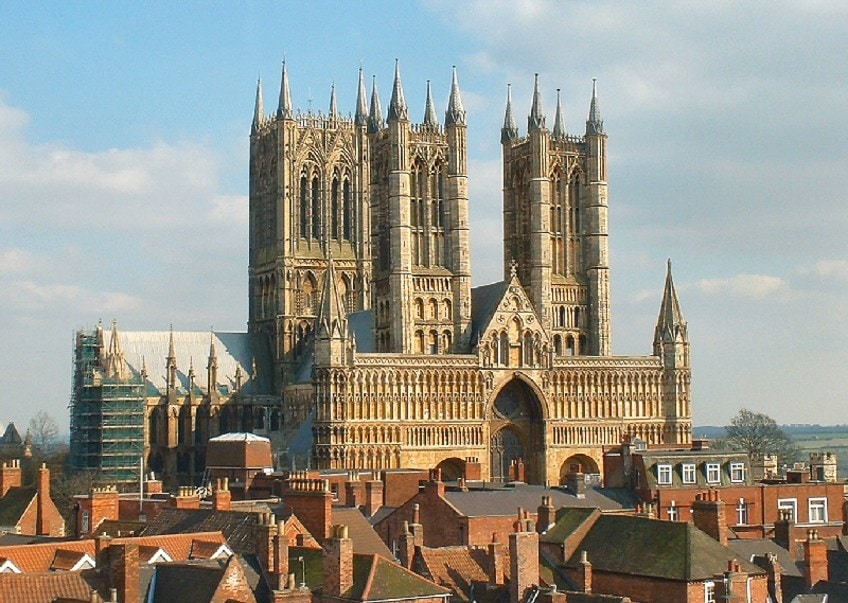 The west front of Lincoln Cathedral equally seen from the Castle wall;Brian, CC BY-SA 2.0, via Wikimedia Eatables
The west front of Lincoln Cathedral equally seen from the Castle wall;Brian, CC BY-SA 2.0, via Wikimedia Eatables
The following year, a Carthusian monk named Hugh of Avalon arrived from Switzerland. In one case in Lincoln, he took on the function of Bishop of Lincoln and started a building program that was set to totally transform the English language church into one of the most historic buildings around the world. With Hugh at the captain, the choir and the eastern transepts were reconstructed, an undertaking that would take up to 1210 to reach completion. From 1215 to 1255 the Galilee or great transept was added too as the chapter house. Work on the central tower was as well begun.
Chartres Cathedral (1194)
| Location of Gothic Structure | Chartres, French republic |
| Year Built | 1194 |
| Architect(southward) | Unknown |
| Role of Building | Church building |
Chartres Cathedral is named subsequently the boondocks in which information technology is congenital and it is the seat of the Bishop of Chartres. Construction on the structure started in 1194 and continued until 1220. It was congenital on the site that had throughout the previous years been occupied past at least five cathedrals. The cathedral was designed in the High Gothic style, and due to information technology being considered a highlight of French Gothic architecture information technology was listed by UNESCO every bit a World Heritage Site.
Much of the church building is still in its original land, with only a few changes made since the beginning of the 13th century.
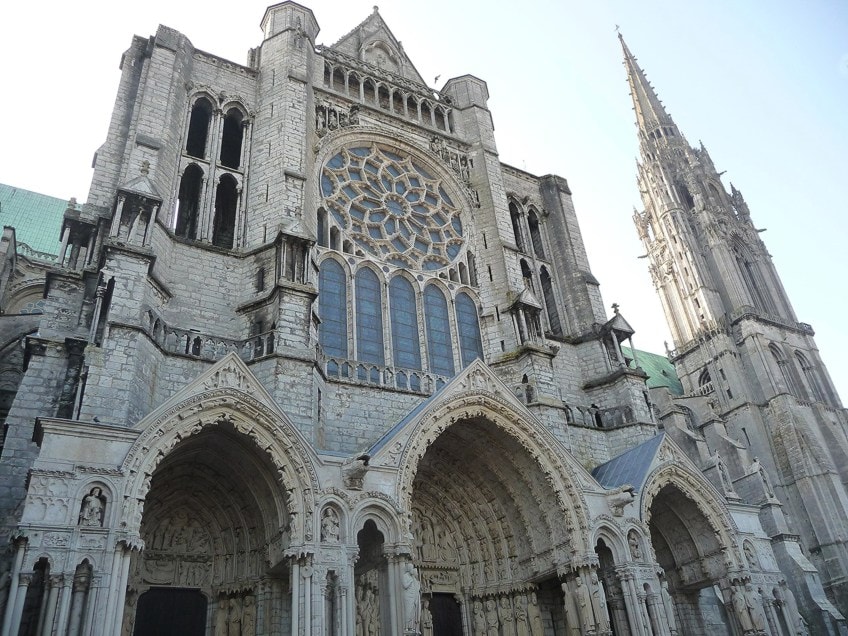 The exterior of the Chartres Cathedral in Chartres, France;Lucie2beaugency, CC Past-SA 4.0, via Wikimedia Commons
The exterior of the Chartres Cathedral in Chartres, France;Lucie2beaugency, CC Past-SA 4.0, via Wikimedia Commons
Most of the stained drinking glass that was originally installed is still intact in this remarkably well-preserved and maintained edifice. The windows of the edifice are considerably large, which was made possible past the use of heavy flying buttresses on the outside. The cathedral has been a point of pilgrimage for many Christians since the 12th century due to the church building being in possession of the Sancta Camisa, believed to exist a slice of habiliment worn at Christ's nascency by his mother, Mary.
Zagreb Cathedral (1217)
| Location of Gothic Construction | Zagreb, Croatia |
| Year Built | 1217 |
| Builder(s) | Later work – Hermann Bollé (1845 – 1926) |
| Function of Building | Cathedral |
Zagreb Cathedral is situated in Kaptol and measures in as the tallest building in Croatia. It is also regarded as the nearly monumental sacred building in the region. The unabridged construction has been designed in the Gothic style and its sacristy is particularly admired as a valuable addition in the world of Gothic architecture.
As was common for many European churches from this menses, the cathedral was demolished past invading Mongol forces in 1242.
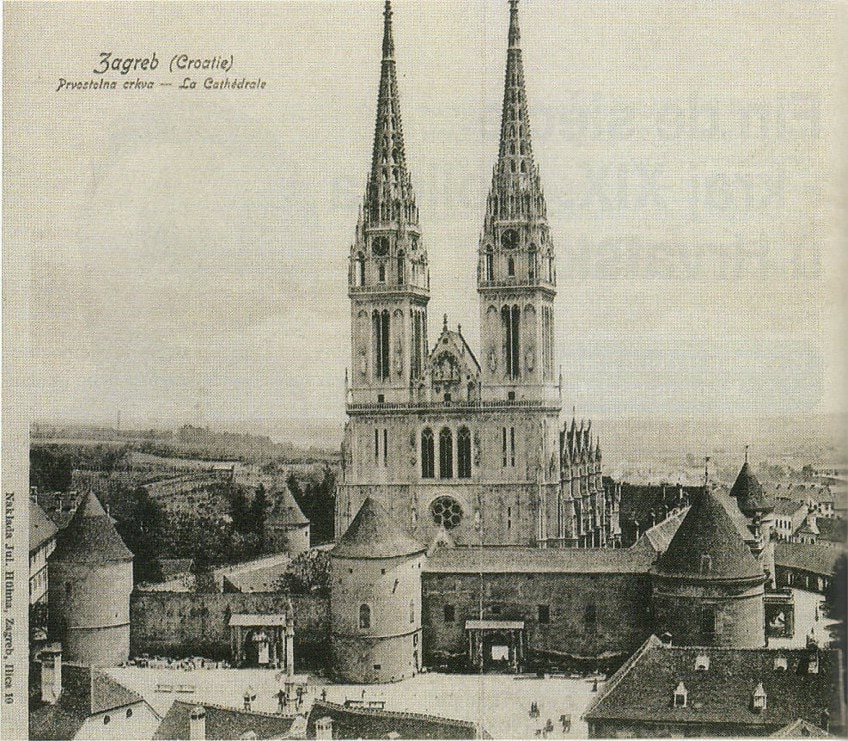 The Zagreb Cathedral afterward being renovated according to the designs of Hermann Bollé (finish of the 19th century);No machine-readable author provided. Neoneo13 causeless (based on copyright claims)., Public domain, via Wikimedia Eatables
The Zagreb Cathedral afterward being renovated according to the designs of Hermann Bollé (finish of the 19th century);No machine-readable author provided. Neoneo13 causeless (based on copyright claims)., Public domain, via Wikimedia Eatables
Information technology would, however, be rebuilt a few years later on. To assistance prevent farther impairment and to protect the area, the cathedral was fortified just earlier the Ottoman Invasion in the 15th century. Many years afterward it would in one case over again be damaged due to the Zagreb Earthquake of 1880. When information technology was once once more restored it was reconstructed in the Neo-Gothic fashion by Hermann Bollé.
Salisbury Cathedral (1220)
| Location of Gothic Structure | Salisbury, United kingdom |
| Year Built | 1220 |
| Architect(s) | Richard Poore (c. 1228) |
| Part of Building | Cathedral |
Salisbury Cathedral is situated in Salisbury, Britain, and is regarded as a prime instance of Gothic architecture in England. The principal body of the trunk took 38 years to complete. Construction started in 1220 and the building was complete by 1258. The spire was added to the cathedral in 1320 and since 1561 it has been rated as the tallest in the United kingdom.
The interior of the spire is made of erstwhile wooden scaffolding and is hollow, and then tourists are able to take tours of the spire.
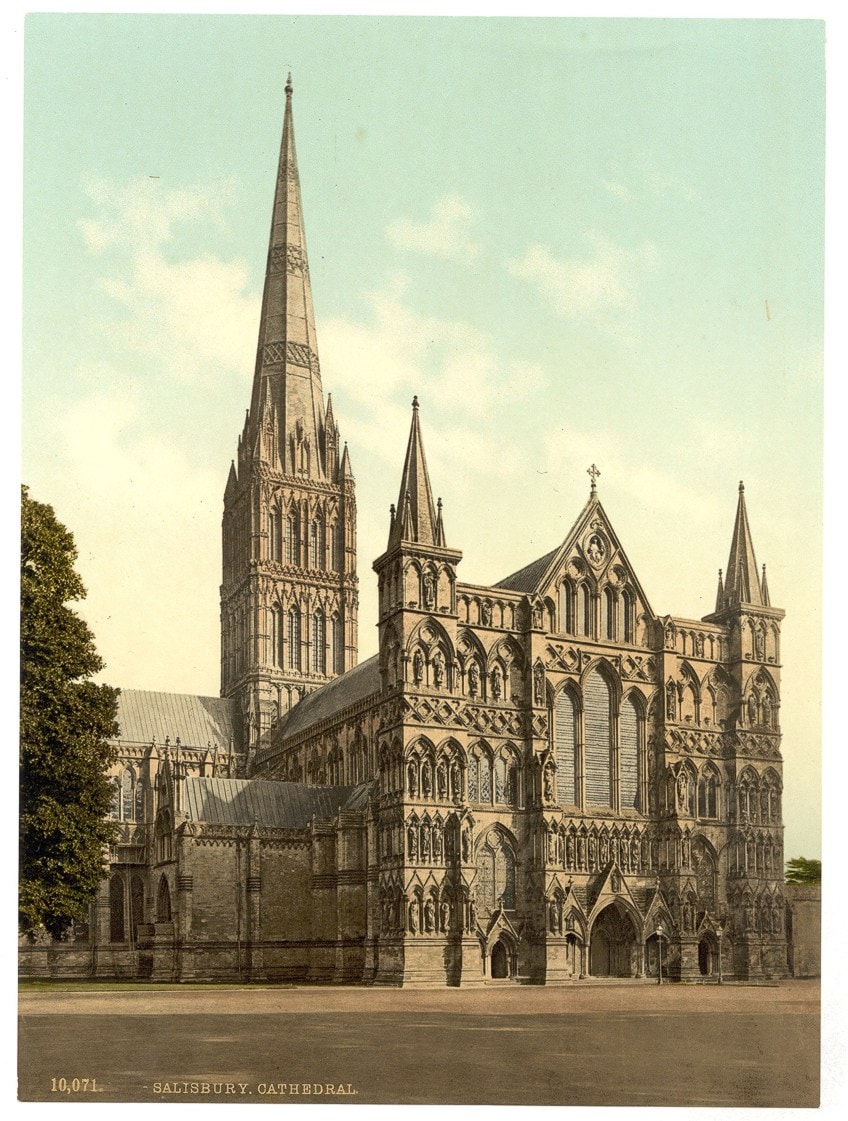 Salisbury Cathedral, England, between 1890 and 1900;Photochrom Impress Collection, Public domain, via Wikimedia Eatables
Salisbury Cathedral, England, between 1890 and 1900;Photochrom Impress Collection, Public domain, via Wikimedia Eatables
The majestic cathedral is also renowned for having the largest cathedral shut and cloister in all of Britain. It also contains the Salisbury Cathedral clock, which is a large iron-framed mechanical clock without a dial. It is known as the oldest working clock globally. The royal charter of rights known as the Magna Carta originally was made into four copies, 1 of which now resides at Salisbury Cathedral. The 750th anniversary of its consecration was celebrated in 2008.
Amiens Cathedral (1220)
| Location of Gothic Structure | Amiens, French republic |
| Yr Congenital | 1220 |
| Architect(due south) | Robert of Luzarches (c. 13th century) |
| Role of Edifice | Cathedral |
The Amiens Cathedral is situated in Amiens on a ridge overlooking the Somme River. Information technology is the seat of the Bishop of Amiens and was built as a Roman Catholic church. Construction on the cathedral began in 1220 and was completed around 1270, which for a Gothic church is a very short time. This has resulted in a rather unusual unity of style, as many other Gothic buildings were built over the span of hundreds of years and therefore were discipline to several different phases and styles during their construction.
The cathedral displays a few features of the Rayonnant fashion of the afterwards period with its employ of loftier windows in the choir, which were added in the 1250s. It is a prime number example of the High Gothic fashion.
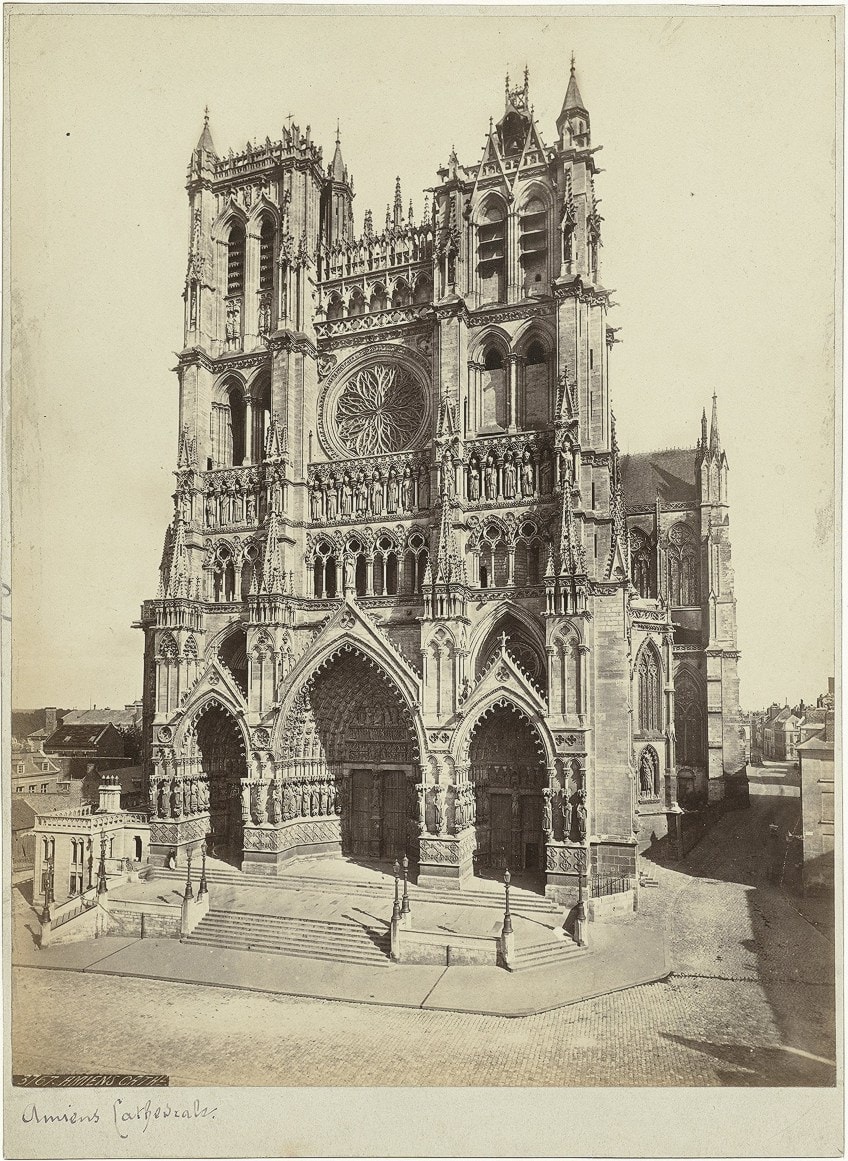 Amiens Cathedral, 1890-1900;Rijksmuseum, CC0, via Wikimedia Commons
Amiens Cathedral, 1890-1900;Rijksmuseum, CC0, via Wikimedia Commons
The architects sought to maximize the internal dimensions of the cathedral in society to bring in more lite and attain for the heavens. By doing so they created the largest cathedral in the entire French region. It has unfortunately lost most of the original stained glass, but due to the beauty and quality of its 13th-century architecture, it was listed by UNESCO equally a World Heritage Site in 1981.
York Minster (1230)
| Location of Gothic Construction | York, England |
| Year Congenital | 1230 |
| Architect(s) | Unknown |
| Part of Building | Cathedral |
York Minster is the official cathedral of York, England, and in Northern Europe, information technology is considered i of the largest cathedrals of its kind. The cathedral is the seat of the Archbishop of York and nether the Dean of York, it is run by a chapter. Subsequently a few centuries of construction, it was completed in 1472 and has been dedicated to St. Peter. Churches that were built during the Anglo-Saxon era that were used for missionary piece of work are known by their honorary championship equally "ministers".
The largest medieval stained-glass window tin be found in the minster, known as the West Window.
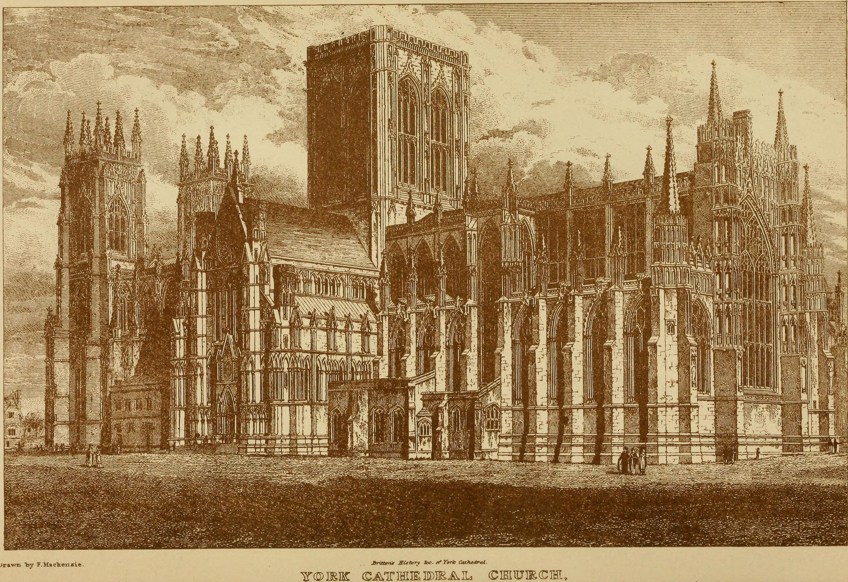 An 1886 illustration of York Minster;Hunnewell, James Frothingham, 1832-1910, No restrictions, via Wikimedia Commons
An 1886 illustration of York Minster;Hunnewell, James Frothingham, 1832-1910, No restrictions, via Wikimedia Commons
Robert Petty, a Chief glazier, produced the rose window in 1515. The rose window consists of an outer row of panels that consist of Lancastrian cerise roses which alternate with the white and red Tudor roses in every second panel. This was symbolic of the joining together of the Houses of York and Lancaster, when in 1486 Henry VII and Elizabeth of York married, creating the House of Tudor which was to exist the new ruling firm. The site on which York Minster was constructed was first used to build a temporary church for the rex of Northumbria, Rex Edwin to be baptized. It was only properly completed 252 years afterward.
The Cologne Cathedral (1248)
| Location of Gothic Construction | Cologne, Frg |
| Yr Built | 1248 |
| Architect(s) | Master Gerhard (1210 – 1271) Ernst Friedrich Zwirner (1802 – 1861) |
| Office of Building | Cathedral |
This massive and beautiful Gothic cathedral is situated in the city of Cologne in Germany. This revered monument of Catholicism in Germany is also the seat of the Archbishop of Cologne and was designed by Primary Gerhard, besides as further designs through the years past Ernst Friedrich Zwirner and many others. Work first began on the cathedral in 1248 but it was abandoned in 1473. It would remain incomplete for more than 350 years until work once again resumed in the 1840s. Information technology would only be completed to the original program in 1880.
Information technology has the 2nd-tallest spires and is the largest cathedral designed in the Gothic mode in Northern Europe.
 The side of the Cologne Cathedral, the Rhine, Germany, between 1890 and 1900;See page for author, Public domain, via Wikimedia Commons
The side of the Cologne Cathedral, the Rhine, Germany, between 1890 and 1900;See page for author, Public domain, via Wikimedia Commons
During the unsafe and turbulent catamenia of the Second World War, the cathedral was severely damaged after being hit by several bombs. While the metropolis of Cologne lay in ruins effectually it, much of the Gothic construction remained intact, despite the heavy damage. In March of 1945, the cathedral was as well subjected to a tank boxing between the American and German forces. Once the state of war had ended, the famous Gothic cathedral underwent a series of long and extensive efforts to repair the construction which is notwithstanding going on in the present.
Orvieto Cathedral (1290)
| Location of Gothic Construction | Orvieto, Italy |
| Year Built | 1290 |
| Architect(south) | Lorenzo Maitani (1275 – 1330) |
| Office of Building | Cathedral |
The Corporal of Bolsena is a relic that tells of a phenomenon concerning a priest who was having doubts about sure aspects of his faith when his ritual Host bread started bleeding all over the textile on the altar. Pope Urban IV and then ordered that a edifice be constructed to provide the relic with a home. The Orvieto Cathedral is positioned in a manner that overlooks the town, congenital on elevation of the plug of a volcano.
Due to the span of fourth dimension it took to build the cathedral, the facade contains elements of various architectural styles from the 14th all the way to the 20th century.
 Orvieto Cathedral;Adriano at Italian Wikipedia, CC BY-SA 3.0, via Wikimedia Commons
Orvieto Cathedral;Adriano at Italian Wikipedia, CC BY-SA 3.0, via Wikimedia Commons
The cathedral'south facade is strikingly beautiful and is considered a classic piece of compages in the religious earth. Information technology contains three massive doors fabricated of bronze, gorgeous golden mosaics, and a huge rose window. On the interior of the cathedral, scenes such every bit Judgment Day take been created into frescoes that were painted by some of the best artists in Italia at the time. During the Renaissance menses, 5 bells were installed in the cathedral, which was tuned to E flat.
Santa Maria del Fiore (1296)
| Location of Gothic Structure | Florence, Tuscany |
| Yr Built | 1296 |
| Architect(southward) | Arnolfo di Cambio (1232 – 1302) |
| Function of Building | Cathedral |
The Santa Maria del Fiore, too known equally the Florence Cathedral. Designed by Arnolfo di Cambio, construction started in 1296 and finished in 1436. Filippo Brunelleschi was responsible for engineering science the dome. Pink and green shades of polychrome marble were used for the exterior of the church building and the facade is created in the Gothic revival fashion.
The complex of the cathedral also includes two other buildings known equally Giotto'southward Campanile and the Baptistry and together the three buildings are listed past UNESCO as a Globe Heritage Site.
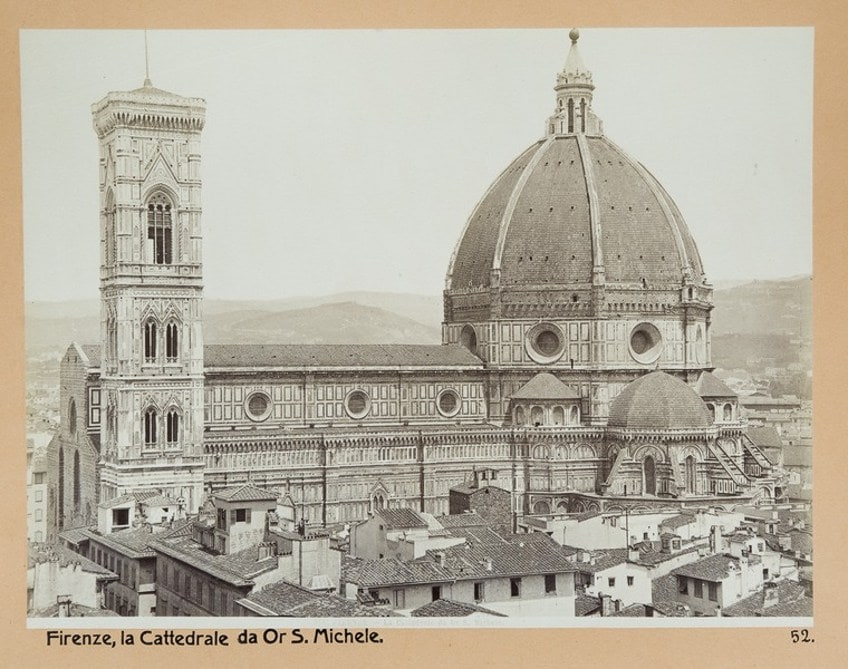 Florence Cathedral;Hallwyl Museum, Public domain, via Wikimedia Commons
Florence Cathedral;Hallwyl Museum, Public domain, via Wikimedia Commons
Florence Cathedral is likewise one of the largest churches in Italy and until recent developments in architectural materials, the dome was the largest in the world in its time. To this day, all the same, information technology still remains the largest dome ever constructed out of brick. The archbishop of the cathedral is Giuseppe Betori and it is the mother church of the Archdiocese of Florence.
Saint Vitus Cathedral (1344)
| Location of Gothic Structure | Prague, Czech Democracy |
| Year Congenital | 1344 |
| Architect(s) | Peter Parler (1333 – 1399) |
| Function of Building | Cathedral |
This Roman Catholic cathedral is situated in Prague. Upwards until 1997, the church was only dedicated to i saint and therefore is still commonly referred to as Saint Vitus Cathedral, despite its full name containing the names of three saints in total, including the saints Wenceslaus and Adalbert. The Roman Catholic cathedral is as well the seat of the Archbishop of Prague.
Many prominent people of the Czech Commonwealth have had their remains housed at the cathedral after they had passed away.
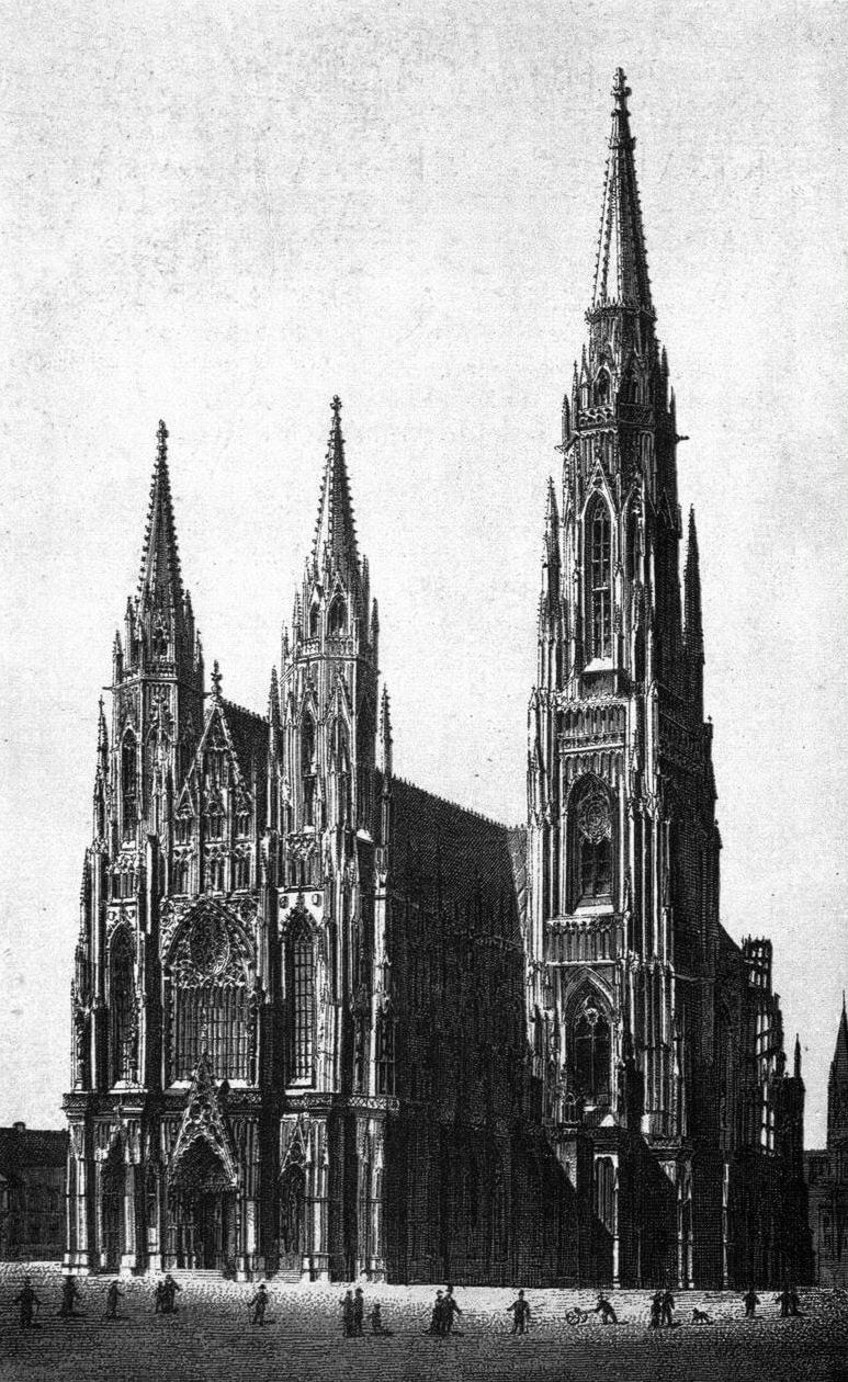 Saint Vitus Cathedral, 1883;Josef Mocker (1835-1899), Public domain, via Wikimedia Commons
Saint Vitus Cathedral, 1883;Josef Mocker (1835-1899), Public domain, via Wikimedia Commons
The cathedral is situated inside Prague Castle and houses the remains of many Holy Roman Emperors and Bohemian kings. The Gothic church was designed by Peter Parler and construction started in 1344. All works, including additions, lasted upwardly until 1929. Information technology is the largest too as the most important cathedral in the entire country and is considered a prime example of Gothic architecture. The cathedral would have a great influence on Fundamental Europe regarding the development of the Late Gothic style. Parler and his workshop designed many other buildings and cathedrals across fundamental Europe.
Milan Cathedral (1386)
| Location of Gothic Structure | Milan, Italy |
| Yr Built | 1386 |
| Architect(s) | Donato Bramante (1445 – 1514) Giovanni Antonio Amadeo (1447 – 1522) |
| Function of Building | Cathedral |
The Milan Cathedral is situated in Milan, Italy, and is yet some other instance of a Gothic cathedral that took hundreds of years to complete, more than 600 years in fact. Designed by architects Donato Bramante and Giovanni Antonio Amadeo, construction on the Gothic cathedral began in 1386.
Despite an initial rapid start in 1386, with half of the cathedral existence built by 1402, a lack of available funds put a major obstacle in the path of further construction efforts.
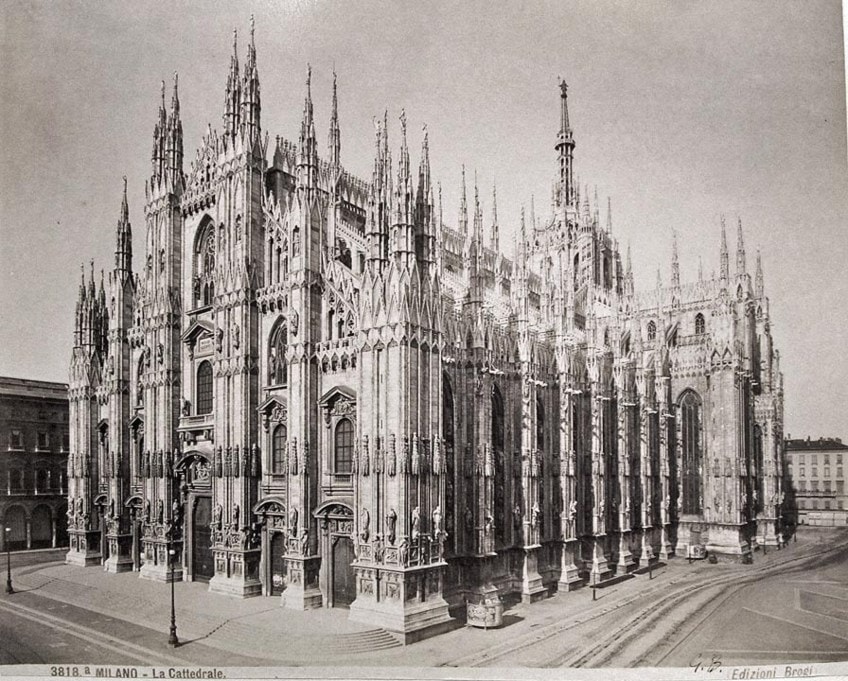 Milan Cathedral; Public Domain, Link
Milan Cathedral; Public Domain, Link
The majority of the construction wasn't even most completion until 1865. Due to the bombing of Milan in Earth War II, the construction was delayed fifty-fifty further. It was not until 1965 that the building was completed in the class it currently stands. It is world-renowned for its masses of complex pinnacles and spires which serve both structural equally well equally artful purposes. It is rated as the 3rd largest cathedral globally, and the facade is specially admired for its highly ornate decorations and detail.
The Grote Kerk (1410)
| Location of Gothic Structure | Breda, Netherlands |
| Year Built | 1547 |
| Architect(s) | Jan Two Keldermans (1375 – 1445) |
| Function of Building | Monument |
Brede is a city in the Netherlands and The Grote Kerk is its most important landmark and monument. This beautifully synthetic monument was built in the Brabantine Gothic style and the shape of the Latin Cross has been incorporated into its blueprint. The choir was the commencement section to exist constructed in 1410. In 1457 the tower collapsed and it took from 1568 until 1509 to build the new tower.
The remainder of the cathedral was gear up to open past 1468, however.
 South-east facade of the Grote Kerk, Breda, the Netherlands; Rijksdienst voor het Cultureel Erfgoed, CC By-SA iv.0, via Wikimedia Eatables
South-east facade of the Grote Kerk, Breda, the Netherlands; Rijksdienst voor het Cultureel Erfgoed, CC By-SA iv.0, via Wikimedia Eatables
In 1694 the tower spire caught fire and was irreparably damaged, therefore a new one was built in its identify in 1702. The building has seen many restorations over the centuries with the last major 1 taking place from 1993 to 1998. The church has been used for many different purposes over the years but is currently used every bit a venue to host various events.
Today we have learned that Gothic architecture start arose in the High and Belatedly Heart Ages in Europe. Information technology started in the 12th century and was at its prime number until the 16th century, but it continued to flourish in some areas into the 17th and 18th centuries. Information technology followed the Romanesque period of Medieval Europe and was followed by the Renaissance period.
Oftentimes Asked Questions
In Which Country Did the Gothic Fashion Outset Sally?
Early Gothic architecture first originated in northern France. The Abbey of Saint-Denis is considered to be the first proper Gothic structure. Gothic vs Romanesque architecture differs in that Romanesque arches are rounded, whereas the new Gothic style incorporated pointed arches instead.
What Are Some of the Characteristics of Gothic Architecture?
Gothic mode architecture can exist recognized by the use of pointed arches also equally other structural elements such equally rib vaulting, columns, piers, flying buttresses which would add extra weight support on the outer side of the structure, gargoyles, and ornate tracery, and stained-drinking glass windows. By using these new structural elements, Gothic architects were able to design and build structures that were higher and allowed in more light than the structures that came earlier.
Source: https://artincontext.org/gothic-architecture/